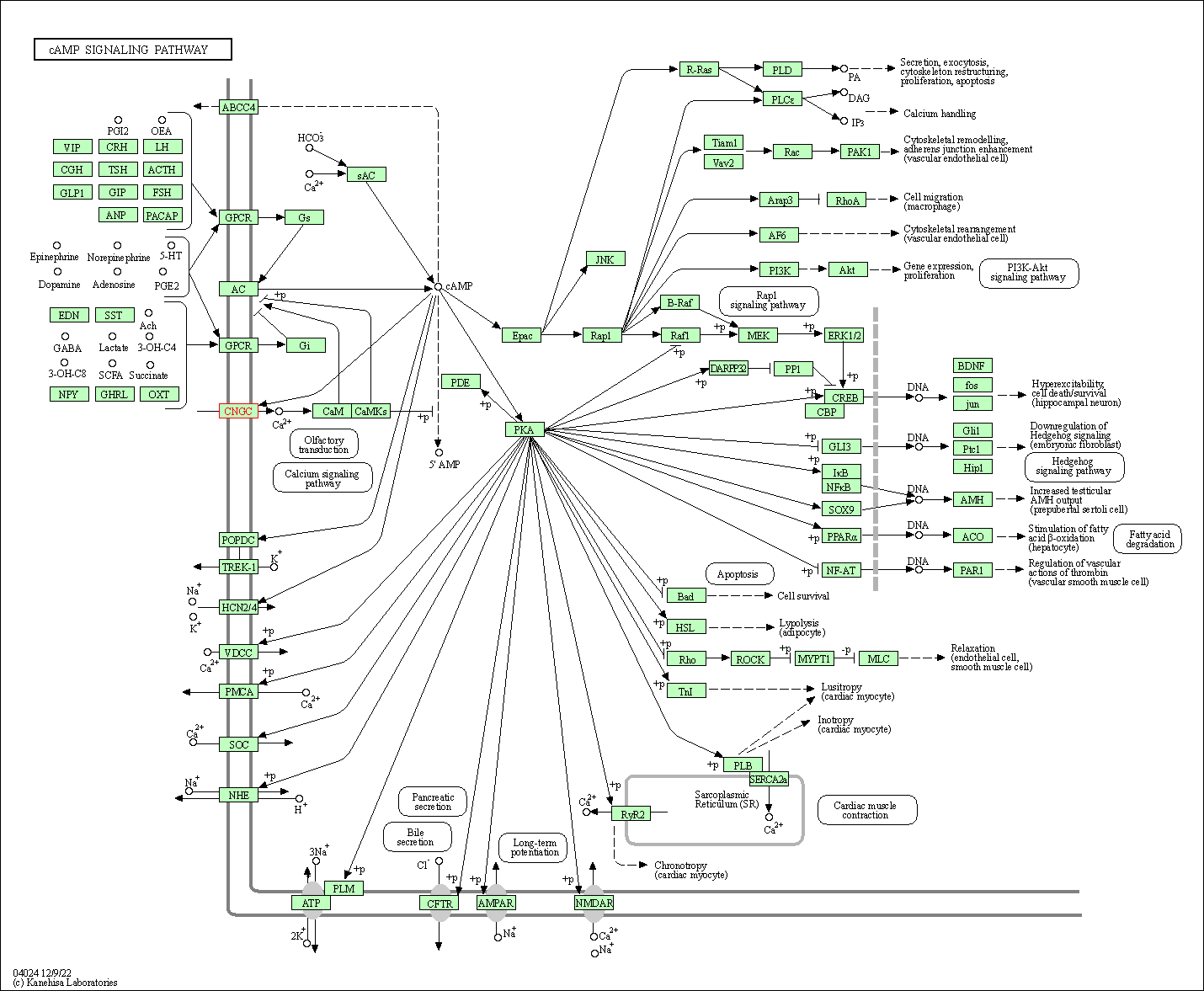Target Information
| Target General Information | Top | |||||
|---|---|---|---|---|---|---|
| Target ID |
T34204
(Former ID: TTDI03121)
|
|||||
| Target Name |
Cyclic nucleotide-gated channel alpha-2 (CNGA2)
|
|||||
| Synonyms |
Cyclic nucleotide-gated olfactory channel; Cyclic nucleotide-gated cation channel 2; CNG2; CNG-2; CNG channel alpha-2; CNCG2; CNCA1; CNCA
Click to Show/Hide
|
|||||
| Gene Name |
CNGA2
|
|||||
| Target Type |
Clinical trial target
|
[1] | ||||
| Disease | [+] 1 Target-related Diseases | + | ||||
| 1 | Myelopathy [ICD-11: 8B42] | |||||
| Function |
Odorant signal transduction is probably mediated by a G-protein coupled cascade using cAMP as second messenger. The olfactory channel can be shown to be activated by cyclic nucleotides which leads to a depolarization of olfactory sensory neurons.
Click to Show/Hide
|
|||||
| UniProt ID | ||||||
| Sequence |
MTEKTNGVKSSPANNHNHHAPPAIKANGKDDHRTSSRPHSAADDDTSSELQRLADVDAPQ
QGRSGFRRIVRLVGIIREWANKNFREEEPRPDSFLERFRGPELQTVTTQEGDGKGDKDGE DKGTKKKFELFVLDPAGDWYYCWLFVIAMPVLYNWCLLVARACFSDLQKGYYLVWLVLDY VSDVVYIADLFIRLRTGFLEQGLLVKDTKKLRDNYIHTLQFKLDVASIIPTDLIYFAVDI HSPEVRFNRLLHFARMFEFFDRTETRTNYPNIFRISNLVLYILVIIHWNACIYYAISKSI GFGVDTWVYPNITDPEYGYLAREYIYCLYWSTLTLTTIGETPPPVKDEEYLFVIFDFLIG VLIFATIVGNVGSMISNMNATRAEFQAKIDAVKHYMQFRKVSKGMEAKVIRWFDYLWTNK KTVDEREILKNLPAKLRAEIAINVHLSTLKKVRIFHDCEAGLLVELVLKLRPQVFSPGDY ICRKGDIGKEMYIIKEGKLAVVADDGVTQYALLSAGSCFGEISILNIKGSKMGNRRTANI RSLGYSDLFCLSKDDLMEAVTEYPDAKKVLEERGREILMKEGLLDENEVATSMEVDVQEK LGQLETNMETLYTRFGRLLAEYTGAQQKLKQRITVLETKMKQNNEDDYLSDGMNSPELAA ADEP Click to Show/Hide
|
|||||
| 3D Structure | Click to Show 3D Structure of This Target | AlphaFold | ||||
| Drugs and Modes of Action | Top | |||||
|---|---|---|---|---|---|---|
| Clinical Trial Drug(s) | [+] 1 Clinical Trial Drugs | + | ||||
| 1 | dequalinium | Drug Info | Clinical trial | Myelopathy | [2] | |
| Mode of Action | [+] 2 Modes of Action | + | ||||
| Blocker (channel blocker) | [+] 2 Blocker (channel blocker) drugs | + | ||||
| 1 | dequalinium | Drug Info | [1] | |||
| 2 | L-(cis)-diltiazem | Drug Info | [4] | |||
| Inhibitor (gating inhibitor) | [+] 2 Inhibitor (gating inhibitor) drugs | + | ||||
| 1 | all-trans-retinal | Drug Info | [3] | |||
| 2 | PIP3 | Drug Info | [5] | |||
| Cell-based Target Expression Variations | Top | |||||
|---|---|---|---|---|---|---|
| Cell-based Target Expression Variations | ||||||
| Different Human System Profiles of Target | Top |
|---|---|
|
Human Similarity Proteins
of target is determined by comparing the sequence similarity of all human proteins with the target based on BLAST. The similarity proteins for a target are defined as the proteins with E-value < 0.005 and outside the protein families of the target.
A target that has fewer human similarity proteins outside its family is commonly regarded to possess a greater capacity to avoid undesired interactions and thus increase the possibility of finding successful drugs
(Brief Bioinform, 21: 649-662, 2020).
Human Pathway Affiliation
of target is determined by the life-essential pathways provided on KEGG database. The target-affiliated pathways were defined based on the following two criteria (a) the pathways of the studied target should be life-essential for both healthy individuals and patients, and (b) the studied target should occupy an upstream position in the pathways and therefore had the ability to regulate biological function.
Targets involved in a fewer pathways have greater likelihood to be successfully developed, while those associated with more human pathways increase the chance of undesirable interferences with other human processes
(Pharmacol Rev, 58: 259-279, 2006).
Human Similarity Proteins
Human Pathway Affiliation
|
|
|
There is no similarity protein (E value < 0.005) for this target
|


| KEGG Pathway | Pathway ID | Affiliated Target | Pathway Map |
|---|---|---|---|
| cAMP signaling pathway | hsa04024 | Affiliated Target |

|
| Class: Environmental Information Processing => Signal transduction | Pathway Hierarchy | ||
| Olfactory transduction | hsa04740 | Affiliated Target |

|
| Class: Organismal Systems => Sensory system | Pathway Hierarchy | ||
| Drug Property Profile of Target | Top | |
|---|---|---|
| (1) Molecular Weight (mw) based Drug Clustering | (2) Octanol/Water Partition Coefficient (xlogp) based Drug Clustering | |
|
|
||
| (3) Hydrogen Bond Donor Count (hbonddonor) based Drug Clustering | (4) Hydrogen Bond Acceptor Count (hbondacc) based Drug Clustering | |
|
|
||
| (5) Rotatable Bond Count (rotbonds) based Drug Clustering | (6) Topological Polar Surface Area (polararea) based Drug Clustering | |
|
|
||
| "RO5" indicates the cutoff set by lipinski's rule of five; "D123AB" colored in GREEN denotes the no violation of any cutoff in lipinski's rule of five; "D123AB" colored in PURPLE refers to the violation of only one cutoff in lipinski's rule of five; "D123AB" colored in BLACK represents the violation of more than one cutoffs in lipinski's rule of five | ||
| References | Top | |||||
|---|---|---|---|---|---|---|
| REF 1 | State-dependent block of CNG channels by dequalinium. J Gen Physiol. 2004 Mar;123(3):295-304. | |||||
| REF 2 | Pharmacological characterisation of the human small conductance calcium-activated potassium channel hSK3 reveals sensitivity to tricyclic antidepressants and antipsychotic phenothiazines. Neuropharmacology. 2001 May;40(6):772-83. | |||||
| REF 3 | All-trans-retinal shuts down rod cyclic nucleotide-gated ion channels: a novel role for photoreceptor retinoids in the response to bright light Proc Natl Acad Sci U S A. 2002 Jun 11;99(12):8372-7. | |||||
| REF 4 | Primary structure and functional expression of a cyclic nucleotide-activated channel from olfactory neurons. Nature. 1990 Sep 13;347(6289):184-7. | |||||
| REF 5 | Interplay between PIP3 and calmodulin regulation of olfactory cyclic nucleotide-gated channels. Proc Natl Acad Sci U S A. 2006 Oct 17;103(42):15635-40. | |||||
If You Find Any Error in Data or Bug in Web Service, Please Kindly Report It to Dr. Zhou and Dr. Zhang.

